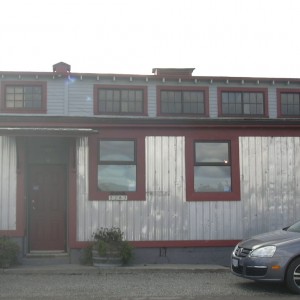George Ward Packing House
Place Description
The historic place is the one- and two-storey metal-sided George Ward Packing House, built in 1926 to support fruit-growing activities. It is located at 2287 Ward Road in the rural East Kelowna neighbourhood of the City of Kelowna.
Heritage Value
The value of the George Ward packinghouse is seen in its presence as one of the few such structures remaining in the City of Kelowna, thereby being an important representative of this highly significant industry; and also in its architectural details of packinghouse form and character. It is also important for having been used by the same family for more than three-quarters of a century.
Long associated with the orchard industry, this packing house and its associated cold storage facility were developed in 1926 by George Ward and his sons Harry and Arthur. The Wards packed and shipped their fruit under the Apex Orchard Co. Ltd. label, through Sales Service Ltd., until 1939, when centralized selling was introduced. Now owned by the Turton family and operated by Canada West Tree Fruits Ltd., the building remains today as a vital part of the East Kelowna agricultural community. The historic place therefore represents the continuity of the fruit-packing industry in the Kelowna region over the period of 80 years.
The original owner also has heritage value as a representative of the new arrivals to Kelowna who took up orcharding in addition to having a skilled trade. George Washington Ward (1888-1955) was born in London, England and came to Canada early in the twentieth century. Having learned the trade of bricklaying in Britain, he became a building contractor in Montreal in partnership with Arthur Baldock. In 1911 the partners moved their operation from Montreal to Kelowna. Besides continuing in the contracting business, G.W. Ward started a fruit orchard in Glenmore. In 1919 Ward and Baldock took over the closed Clement and Riggs brickyard at the foot of Knox Mountain, and operated it for several years before selling it to W. Haug and Sons.
In 1926 G.W. Ward (with his sons Harry and Arthur) took over the property of the South Kelowna Land and Orchard Company and formed the Apex Orchard Company. G.W. Ward was president until his death in 1955. The Wards moved to South Kelowna from Glenmore in 1927.
They inherited a small packing shed on the property. They enlarged it and added a cold storage facility. They packed and shipped fruit under the Apex label. Apex ceased packing in 1939 when central selling came in, and the building has since served as a storage facility. The orchard operation continues in the family: it is now owned (since about 1970) by Ted and Chris Turton (G.W. Ward's nephews) of Canada West Tree Fruits Ltd. The building is still largely unaltered, except for the creation of office space at the front.
This is one of the few packinghouses left outside the North End. At one time there were numerous of these independent facilities, but most have been torn down (or burned down) over the years.
The typical large footprint building, with its utilitarian metal siding, clerestory natural lighting, large roof vents and low-sloped roof provide a valuable visual image of the nature and scale of packing house operations for the fruit industry in the Okanagan Valley.
The site is used for today for fermentation produce from apples.
Character Defining Elements
- Dominant fruit-processing building located at a street intersection on a large orchard property
- Mature trees and decorative pattern of columnar evergreen trees facing the street
- Industrial form, scale and massing, expressed by the variable height and long rectangular plan on gently sloping land, providing access at different levels
- Low-pitch shed roof on 2 levels, with projecting ridge vents
- Eaves supported by exposed wood joists
- All walls have had metal cladding added over the horizontal wood siding, except in the upper clerestory portion of the building
- Clerestory windows between the roofs, with fixed-pane painted wood sliding sash
- Large loading doors
- Fixed-pane windows of various window sizes on the ground floor, responding to their particular functions





